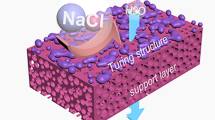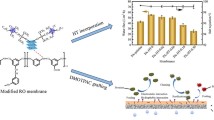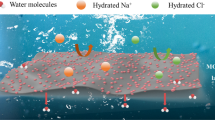Abstract
Excessive amounts of copper ions in the water sources can be harmful to mammals and especially humans. In this study, a new RO composite membrane is fabricated via the interfacial polymerization (IP) reaction of trimesoyl chloride (TMC), piperazine (PZ) and 3,5-diaminobenzoicacid (DABA). The IP reaction was conducted on a polysulfone (PS) layer which acts as a mounting layer for the separation TMC-DABA-PZ layer. The IP reaction time, TMC concentration and transmembrane pressure were the selected study variables. For IP reaction times around 10 s the rejection and flux were equal to 79% and 21.3 L.m−2.h−1, respectively, while increasing the IP reaction time to 40 s elevates the rejection and flux to 92% and 27.7 L.m−2.h−1, respectively. TMC concentrations around 0.05% w/w demonstrated rejection and flux equal to 88% and 14.3 L.m−2.h−1, respectively, while its elevation to 0.2% w/w, increased the rejection and flux to 90% and 17.5 L.m−2.h−1, respectively. As with the transmembrane pressure, the optimum pressure was 20 bars, in which the rejection and flux were 95% and 24.07 L.m−2.h−1, respectively. Membrane morphology tests are also supporting evidence for these results. The mathematical modeling has also shown that the relation between the concentration, rejection and flux parameters match the resultant data from the conducted experiments. Since both the rejection and the flux of the fabricated membranes have shown great results, such membranes can be used for wastewater treatment at industrial scales.
Similar content being viewed by others
Abbreviations
- b1 – b5 :
-
Model constants
- Aw :
-
Diffusive coefficient of solvent (m/h)
- Bs :
-
Diffusive coefficient of solute (m/h)
- C:
-
Concentration (kg/m3)
- Cf :
-
Concentration of solute in the feed (kg/m3)
- Cf0 :
-
Initial concentration of solute in the feed (kg/m3)
- Cft :
-
Concentration of solute in the feed tank (kg/m3)
- Cp :
-
Permeate concentration of solute (kg/m3)
- Cpav :
-
Average permeate concentration (kg/m3)
- Cr :
-
Retentate concentration of solute (kg/m3)
- Cwp :
-
Permeate concentration of solvent (kg/m3)
- Js :
-
Diffusive flux of solute (L/m2.h1)
- Jw :
-
Diffusive flux of solvent (L/m2.h1)
- ΔP :
-
Whole membrane hydraulic pressure (kg/m.h2)
- Qf :
-
Volumetric flow rate of feed (m3/h)
- Qp :
-
Permeate volumetric flow rate (m3/h)
- Qr :
-
Retentate volumetric flow rate (m3/h)
- R:
-
Solute rejection
- Sa :
-
Area of the utilized membrane (m2)
- T:
-
Time (h)
- Vf :
-
Feed volume (m3)
- Vf0 :
-
Initial feed volume (m3)
- Vft :
-
Feed tank volume (m3)
- Vp :
-
Permeate volume (m3)
- π :
-
Osmotic pressure (kg/m.h2)
- Ψ:
-
Osmotic pressure coefficient (m2/h2)
References
Turnlund JR (1998) Human whole-body copper metabolism. Amer J Clin Nutr 67:960S–964S
Yoo J, Shim T, Hur J, Jung J (2016) Role of polarity fractions of effluent organic matter in binding and toxicity of silver and copper. J Hazard Mater 317:344–351
Uauy R, Olivares M, Gonzalez M (1998) Essentiality of copper in humans. Amer J Clin Nutr 67:952S–959S
Barceloux D, Barceloux D (1999) Copper. J Toxicol Clin Toxicol 37:217–230
Gonzalez-Estrella J, Gallagher S, Sierra-Alvarez R, Field JA (2016) Iron sulfide attenuates the methanogenic toxicity of elemental copper and zinc oxide nanoparticles and their soluble metal ion analogs. Sci Total Environ 548–549:380–389
Xiao Y, Peijnenburg WJGM, Chen G, Vijver MG (2016) Toxicity of copper nanoparticles to Daphnia magna under different exposure conditions. Sci Total Environ 563–564:81–88
Gaetke LM, Chow CK (2003) Copper toxicity, oxidative stress, and antioxidant nutrients. Toxicology 189:147–163
Matavos-Aramyan S, Moussavi M, Matavos-Aramyan H, Roozkhosh S (2017) Cryptosporidium-contaminated water disinfection by a novel Fenton process. Free Radic Biol Med 106:158–167
Moussavi M, Matavos-Aramyan S (2016) Chelate-modified fenton treatment of sulfidic spent caustic. Korean J Chem Eng 33:2384–2391
Song L, Vijver MG, Peijnenburg WJGM, Galloway TS, Tyler CR (2015) A comparative analysis on the in vivo toxicity of copper nanoparticles in three species of freshwater fish. Chemosphere 139:181–189
Fitzgerald DJ (1998) Safety guidelines for copper in water. Amer J Clin Nutr 67:1098S–1102S
Cassano A, Rastogi NK, Basile A (2015) 18 - Membrane technologies for water treatment and reuse in the food and beverage industries. In: Advances in membrane technologies for water treatment. Woodhead Publishing, Oxford, pp 551–580
Sörme L, Lagerkvist R (2002) Sources of heavy metals in urban wastewater in Stockholm. Sci Total Environ 298:131–145
Mirbagheri SA, Hosseini SN (2005) Pilot plant investigation on petrochemical wastewater treatmentfor the removal of copper and chromium with the objective of reuse. Desalination 171: 85–93
Aziz HA, Adlan MN, Ariffin KS, metals Heavy (2008) (Cd, Pb, Zn, Ni, Cu and Cr(III)) removal from water in Malaysia: Post treatment by high quality limestone. Bioresour Technol 99:1578–1583
Gabelich CJ, Yun TI, Ishida KP, Leddy MB, Safarik J (2004) The effect of naturally occurring biopolymers on polyamide membrane fouling during surface water treatment. Desalination 161: 263–276
Jegal J, Min SG, Lee K-H (2002) Factors affecting the interfacial polymerization of polyamide active layers for the formation of polyamide composite membranes. J Appl Polym Sci 86:2781–2787
Jee KY, Shin DH, Lee YT (2016) Surface modification of polyamide RO membrane for improved fouling resistance. Desalination 394:131–137
Zimmermann R (1965) Condensation Polymers: By Interfacial and Solution Methods. In: Morgan VPW (ed). Aufl., XVIII, 561 S., zahlr. Abb., mehrere Tab., geb. £ 9.10.?, Angewandte Chemie, 78 (1966) 787-787. Wiley, New York London-Sydney
Belfer S, Purinson Y, Fainshtein R, Radchenko Y, Kedem O (1998) Surface modification of commercial composite polyamide reverse osmosis membranes. J Membr Sci 139:175–181
Hu Y, Lu K, Yan F, Shi Y, Yu P, Yu S, Li S, Gao C (2016) Enhancing the performance of aromatic polyamide reverse osmosis membrane by surface modification via covalent attachment of polyvinyl alcohol (PVA). J Membr Sci 501:209–219
Shafi HZ, Matin A, Khan Z, Khalil A, Gleason KK (2015) Surface modification of reverse osmosis membranes with zwitterionic coatings: A potential strategy for control of biofouling. Surf Coat Technol 279:171–179
Nikolaeva D, Langner C, Ghanem A, Rehim MA, Voit B, Meier-Haack J (2015) Hydrogel surface modification of reverse osmosis membranes. J Membr Sci 476:264–276
Yong Z, Sanchuan Y, Meihong L, Congjie G (2006) Polyamide thin film composite membrane prepared from m-phenylenediamine and m-phenylenediamine-5-sulfonic acid. J Membr Sci 270:162–168
Cadotte JE, Petersen RJ, Larson RE, Erickson EE (1980) A new thin-film composite seawater reverse osmosis membrane. Desalination 32:25–31
Kurihara M, Uemura T, Nakagawa Y, Tonomura T (1985) The thin-film composite low pressure reverse osmosis membranes. Desalination 54:75–88
Amiri MC, Samiei M (2007) Enhancing permeate flux in a RO plant by controlling membrane fouling. Desalination 207:361–369
Zhang J, Li J-D, Gray S (2011) Effect of applied pressure on performance of PTFE membrane in DCMD. J Membr Sci 369:514–525
Author information
Authors and Affiliations
Corresponding author
Rights and permissions
About this article
Cite this article
Matavos-Aramyan, S., Neysari, S. & Jazebizadeh, M. Fabrication, Application and Mathematical Modeling of a new Diamine/Trimesoyl Chloride Reverse Osmosis Composite Membrane for Copper Sulfate Desalination from Wastewaters. Silicon 9, 829–840 (2017). https://doi.org/10.1007/s12633-017-9582-5
Received:
Accepted:
Published:
Issue Date:
DOI: https://doi.org/10.1007/s12633-017-9582-5




